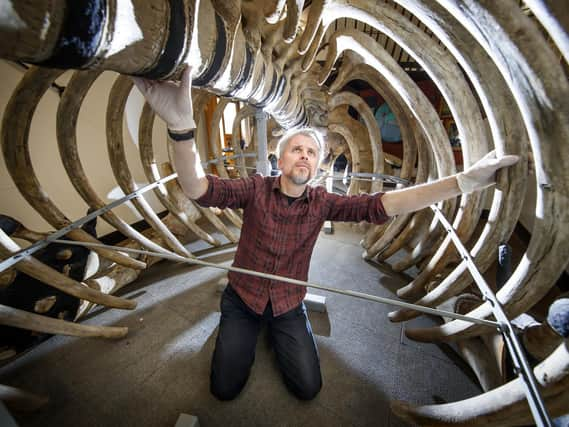Complex cleaning job on 113-year-old whale skeleton begins at Hull Maritime Museum


The bones of the juvenile Northern Atlantic right whale - all 40ft of it - ended up on the other side of the Atlantic in a museum in Hull, where it remains its largest exhibit.
The fragile skeleton and seven others, including a killer whale and a narwhal, were the first objects to be moved today to make way for a £12million upgrade of the Maritime Museum. In total, 50,000 objects will be placed into storage.
Advertisement
Hide AdAdvertisement
Hide AdConservator Nigel Larkin has the job of cleaning and remounting the whale - which was given its name by hunters as the "right" one to catch.
The right whales - which have huge heads - contained not only plentiful oil and baleen, but after being killed would conveniently float on the surface.
Populations were decimated during the whaling heydays and now there are thought to be only 400 left in the world.
Not surprisingly over the years the bones of the eight specimens have gathered a lot of dust and they will be cleaned using soft brushes and hoovered, and depending on how dirty they are, with specialist cleaning products.
Advertisement
Hide AdAdvertisement
Hide AdThe right whale will be remounted, but will be articulated in a more dynamic pose to look as if it is diving down. A perspex bubble inside the skeleton will allow children to "be in the belly of the whale".
Whales, says Mr Larkin, who will work on the bones at his Shropshire conservation studio, conjure up "huge emotions".
Most species were hunted close to extinction and it was "only because people cared about them" and protested in the 1970s that the majority of countries stopped whaling.
As well as renewing a popular exhibition, the right whale skeleton's DNA also has a potential research value for scientists investigating population dynamics.
Advertisement
Hide AdAdvertisement
Hide AdConservation and engagement officer Stathis Tsolis said: “The whale is well-remembered and cherished by many people visiting the museum over the last four decades and it is about to receive some much needed care and conservation.
“North Atlantic right whales are currently endangered, with only an estimated 400 left. These days the threat is largely from ship collisions and entanglement in fishing gear.
“The rarity of this animal adds to the global significance of our specimen, which will hopefully change as time goes by. May the day come when skeletons of right whales are not so rare and important.”
One of the reasons why right whales are so threatened is because they are being killed faster than they can reproduce - females do not become sexually mature until the age of ten and give birth to a single calf after a year's pregnancy.
Advertisement
Hide AdAdvertisement
Hide AdThe juvenile was killed alongside its mother by a 78-year-old retired whaling captain in 1907. The mother's skeleton is stored at the American Museum of Natural History.
The museum's revamp is part of a £30million tourism project aimed at attracting 300,000 visitors a year, which will see the country’s last sidewinder trawler, the Arctic Corsair, move to a new berth at historic dry docks on the River Hull, alongside a state-of-the-art interpretation centre. When the museum reopens in 2023 there will be 50 per cent more space and the public will be able to access to one of its domes for the first time to enjoy stunning rooftop views across the city.
Hull was well known for its whaling museum, and even caught the eye of Herman Melville who mentions it in his 1851 bestseller Moby Dick. Hull was a major whaling port in the 19th century, and at its peak in the 1820s, 60 vessels employed around 3,000 people on and off shore.
Although UK whaling finished in the 1960s, Hull men continued to be recruited to work in the whale processing factory ships in the South Atlantic up until the 1970s.